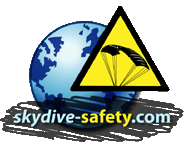
Every year, I receive hundreds of incident reports from the British Parachute Associations and the confidential reporting system, resulting in reserve rides, hospital visits and occasionally a fatality.
Ask yourself one question, can the chances of becoming one of these statistics be reduced?
The answer is YES

The chances of you having a skydiving accident that has not happened to someone else before, is extremely slim. Almost all skydiving accidents are repeats, the same incident happening over and over again, but with different people. Think of a skydiving accident as a repetitive problem.
We have many ways of preventing repetitive problems. The cause is never just one reason but usually a chain of events, by removing a single link in that chain, repetitive incidents can be prevented. Read an example of the "Chain of Events" and how it works.
Each of the following categories can be classed as a single link in the chain of events. Get all of those right and you have a good chance of not becoming one of the statistics. Get one of them wrong and you increase your chances of having a skydiving accident.
• Choosing
the Right Equipment
• Have it Correctly
Assembled
• Repair and Maintenance
• Is it Correctly Packed
• BPA Systems
• Survival Skills
Choosing the right size and type of parachute for your weight and experience is the first stage in preventing a potential accident.
This is easier said than done as all 5 of the following points have to be considered equally and this can get confusing.
The best advise here is talk to as many instructors, riggers, dealers and manufacturers as possible because buying wisely is making sure you have a good safety margin, ready for mistakes that you will make. No one is 100% alert all the time. You want to make sure your canopy lasts you a long time without getting bored with it. However, the biggest mistake is to go to small too soon. Don't let your ego force you into this trap. For the very experienced skydivers consider how often you jump, before you go for the smallest, fastest and most unforgiving canopy.You may look cool during a good landing but you look a right idiot limping back, or being carried away in an ambulance after a bad landing. A small mistake on a high performance canopy can be very costly.
As well as the main parachute, it’s also very important that the container is suitable for the type of skydiving that you intend doing and if required updated or modified when changing skydiving disciplines. The sport has changed so fast and the equipment has changed to keep pace with it, however not all containers are suitable for all disciplines.
Choose a reserve that will keep you safe when you need it most, for example, if you end up on a reserve other factors could also develop, and finding yourself over obstacles with very little landing area whilst on a very fast, small reserve will definitely ruin your day.
When listening to advise that every one will gladly give you, it can get even more confusing. Don¹t forget to ask the reason behind the advise you're getting. Is your advisor biased to a particular canopy or container? because they get a better financial incentive by selling you that equipment. Have they the experience on many different types of systems? to be able to give advise for your requirements, do they give advise and get feed back on a regular basis? and finally have they got your best interest at heart? Good luck because this is probably the hardest decision you will ever have to make.
For more information read real incidents about this topic in the confidential reporting section.
Many mistakes have been put down to the person assembling your system and packing the reserve ready for service, which is something beyond the control of most skydivers, or is it ? Don¹t be led into believing that all qualified packers and riggers are equal, for example one reserve packer may have spent the past 10 years packing only a couple of types of rigs and may have no experience on your system. You could just as easily find a rigger who has spent the past few years just repairing equipment and not packing any reserves.
Training, experience, knowledge and currency are the key requirements. A newly qualified reserve packer or rigger can be better qualified on your equipment than an experienced reserve packer or rigger, or vice versa, so how do you decide who to trust with your life?
The answer is simple, don¹t trust just anyone without getting to know them, find out how well trained they are, how experienced they are, are they current and knowledgeable about your system. What reputation have they got, are they very safety conscious, are they working in a controlled safe environment, have they a thirst for knowledge and keen to keep up to date with the latest safety information.
You can make a difference by doing your own research, make sure you are completely happy with your choice of packer or rigger, so it's a well thought out decision. Remember the more packers and riggers have to justify themselves, the higher the standards will be, and the safer you will be.
For more information read real incidents about this topic in the confidential reporting section.
This category is very similar to the assembly in the way that the same research can be done to choose the right rigger that will keep you safe. The main aim when looking at maintenance is that you should take the advise of a rigger and don't hesitate to spend a little extra on changing that velcro, line or pilot chute before it becomes a problem, preventative maintenance is the best method of avoiding an incident.
Have regular inspections on your kit, and if you have the slightest bit of concern don't hesitate to get advise. When your rig is due for a reserve repack ask for a main canopy inspection if you have any concerns. The main parachute is not part of the normal reserve inspection procedure.
Tell your rigger if you have had any problems no matter how trivial you think they are, get to know what safety notices have been published reference your equipment, and was it mandatory or advisable so you can decide, or at least discuss the options and possible consequences. Broken lines, premature toggle release, pilot chute hesitation, line slump, incompatible components etc can all be prevented by having a keen eye, so keep questioning the serviceability
For more information read real incidents about this topic in the confidential reporting section.
Packing has become an art and there are many ways to achieve the same results. However, far too many reserve rides are down to poor packing. Most people are fairly happy with their pack jobs but the incident reports disagree.
It's very difficult to self criticise your own pack jobs, after all, they have worked very well for probably hundreds of jumps so why revisit an old skill. After a short period of successful pack jobs it becomes very easy to become complacent, resulting in a skill never having been mastered, this is especially true when a change of canopy has taken place as new packing techniques have to be learnt.
Imagine being part of a weekend four way team having a great time for years and suddenly you all get a coach and learn tricks you've never heard of before, well, it's an obvious conclusion that you suddenly get better and the same can be said for packing skills
Tips can be demonstrated to prevent the following types of malfunctions: line over, bag lock, twists, line slump, off heading openings, hard openings etc. Keep watching and asking why so many skydivers pack so differently. However, only take the advise that is relevant to your system.
The last part of packing that can be overlooked, is being familiar with your container and especially the deployment system. If you move to a pin pull system get to know how it can malfunction when packed badly, if you have a kill line system, can you be sure it’s cocked. The biggest most common mistake is the bridle line being incorrectly routed
Packing should also be considered a survival skill, when your parachute opens, ask yourself one question: “did it stay on heading,” If not, do something about it as one day you will get an off-heading opening at the same time as another skydiver and collide causing a serious accident.
Because skydivers get used to parachutes opening off-heading it becomes the normal expectation instead of the rare occurrence that it should be. Learning to pack correctly can help make sure that you open on heading and fly away from other skydivers especially if some one has done a poor track during separation.

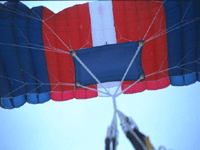
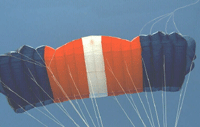
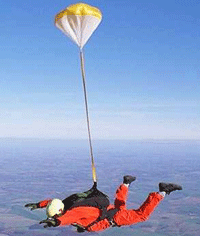

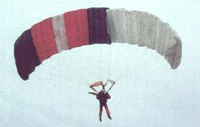
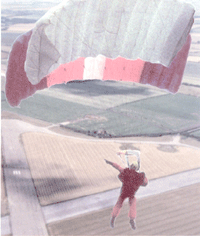
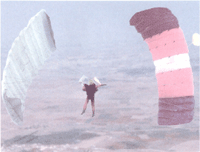
For more information read real incidents about this topic in the confidential reporting section.
Over many years the BPA have adopted systems that are vital in preventing previous incidents from recurring, these systems have been developed by experience and have proven there worth when used correctly.
During a flight line check, skydivers have been stopped from jumping because something was wrong with their equipment. This prevented an incident that was about to happen. The rules are there for safety and if we want to keep skydivers safe we need to follow sensible rules.
Some of the rules that prevent you getting in an aircraft with unsafe kit are as follows:
First is choosing the right packer or rigger who has a duty to insure your kit is safe to jump. Then it’s the kit inspection that all BPA drop zones have to do annually. This is usually the second inspection that can pick up some of the problems, and is well worth doing just for peace of mind. This is usually done by a person independent to the reserve packer.
Thirdly the ‘flight line check’ (This is the inspection you receive to make sure you are properly prepared for your skydive) can be the last check that you will receive before jumping. As long as a conscientious skydiver does this check with the intention of looking for faults, rather than just going through the motion, then it’s well worth it. Next time you get checked, remember it’s in your own interest to have this done well, so if you find you have been missed ask a friend to check you out, it could prove well worth the effort. A couple of points to remember, is your flight line checker qualified and are they familiar with your equipment.
For more information read real incidents about this topic in the confidential reporting section.
This section can be put down to bad altitude awareness, not pulling, poor tracking, poor emergency drills and bad awareness under canopy.
Loss of altitude awareness has caused quite a few reserve rides with skydivers pulling very low or as is stated in many reports the AAD deployed the reserve. This is true for experienced jumpers working hard on a four way team, as well as a student trying hard to master a new skill. Altitude awareness should always be stressed on each skydive.
I have always believed in using the altimeter as the first option of altitude awareness with regular checks during the skydive, and using an audible altimeter as a back up to remind you when you get it wrong. If you rely on just the audible altimeter - as many professional competition teams do - then make sure you have the best for the team and you all have them, and jointly agree that every one is responsible for altitude awareness.
Not being able to find or deploy the pilot chute is also a very regular incident and one that can be reduced by more ground practice. This needs to be a very natural and practiced skill, Keep trying to locate your pilot chute to build up the muscle memory and always check it prior to exit. A good deployment is very important so if you have a pilot chute hesitation, consider whether it was due to a lazy pull , if not get your pilot chute checked by your rigger.
Having good reserve drills is essential when suddenly faced with having to cut away. Practice this survival skill on a regular basis, when your reserve is due a repack put it on and deploy the reserve for real as if you needed it.
Good tracking should be considered a survival skill. It’s important to move away from all other skydivers as far as possible to insure that when your parachute opens, it's not possible for you to collide with another skydiver.
Finally keep a good look out for other parachutes around you, and select your own safe landing area away from other skydivers. Make sure you do a predictable approach pattern and follow local drop zone rules.
I have written a lot about what can go wrong, however the reason for this is to make sure you become an educated skydiver, if you are inquisitive then skydiving can be a very safe and enjoyable sport. The main issue that you have to consider is don't trust anyone until they have proven trust worthy.
For more information read real incidents about this topic in the confidential reporting section.